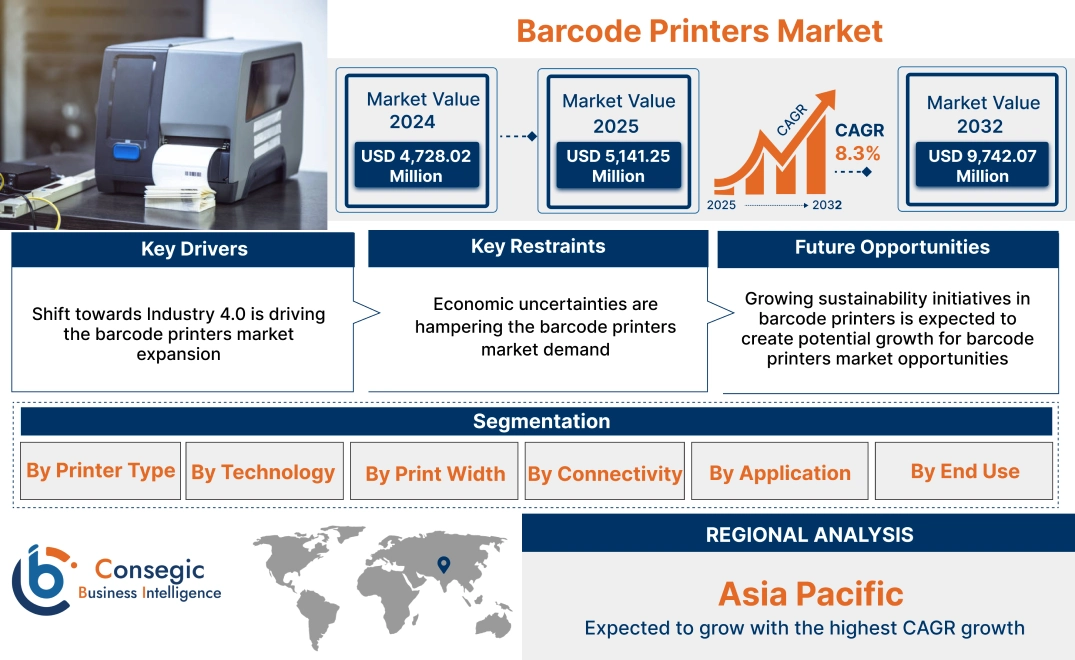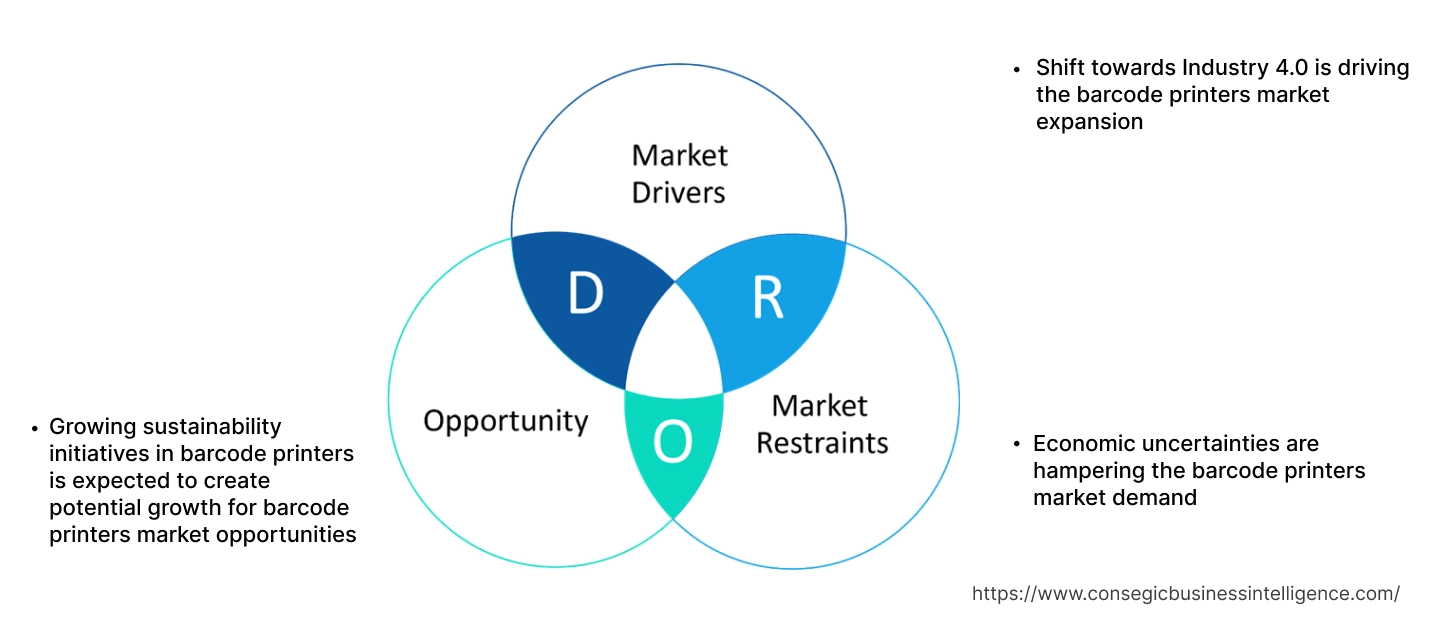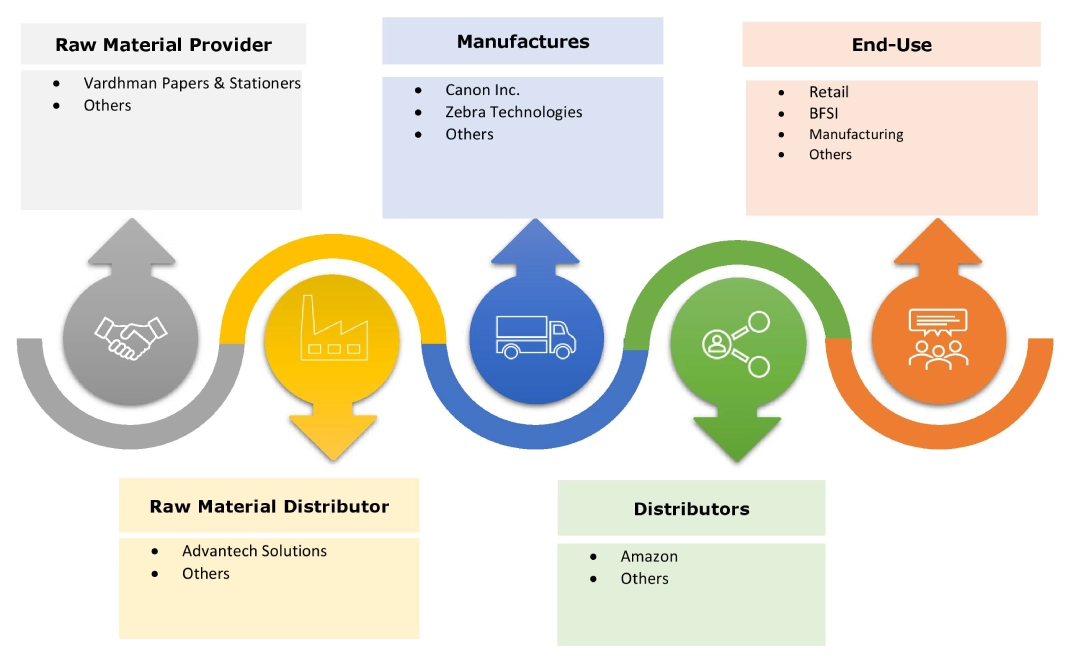- Summary
- Table Of Content
- Methodology
Barcode Printers Market Size:
Barcode Printers Market Size is estimated to reach over USD 9,742.07 Million by 2032 from a value of USD 4,728.02 Million in 2024 and is projected to grow by USD 5,141.25 Million in 2025, growing at a CAGR of 8.3% from 2025 to 2032.
Barcode Printers Market Scope & Overview:
Barcode printers allow businesses to optimize their operations, from warehousing to distribution, by offering real-time insights into inventory levels and movements. This capability not only lowers costs but also enhances customer service through quicker order fulfillment and precise shipment tracking. Technological advancements in barcode printing, including the rise of thermal and mobile barcode printers, have further spurred market expansion. Thermal barcode printers have become popular due to their high print quality, durability, and cost-effectiveness compared to traditional printing methods. Additionally, the integration of barcode printers with cloud-based inventory management systems and enterprise resource planning (ERP) software has improved their usability and scalability across various industries.
Key Drivers:
Shift towards Industry 4.0 is driving the barcode printers market expansion
Industry 4.0 marked by the integration of digital technologies into manufacturing processes, is transforming the industrial landscape. This fourth industrial revolution emphasizes automation, data exchange, and the utilization of cyber-physical systems, IoT, and AI. Barcode printers are crucial in Industry 4.0, ensuring a smooth flow of information and enabling traceability throughout the supply chain. Barcodes serve as unique identifiers for products, parts, and assets, allowing for real-time tracking during the production process, from raw materials to finished goods. Additionally, barcodes provide real-time visibility into the supply chain, enabling businesses to monitor the movement of goods, pinpoint bottlenecks, and enhance logistics. Furthermore, the data collected through barcodes can be analyzed to derive insights into production processes, identify opportunities for improvement, and support informed business decisions.
- For instance, in September 2024, Panasonic Smart Factory Solutions India showcased its intelligent factory solutions at Productronica India 2024. The product series includes MES Solutions PanaCIM, Modular Placement Machines, NPM-G Series surface mount technology (SMT) machines, Microelectronics and Semiconductor solutions, and Inspection Solutions. These solutions are developed for Indian manufacturers, including the NPM-GH modular mounter and NPM/GL screen printer represents a major achievement towards the autonomous factory operations.
Thus, according to the barcode printers market analysis and trends, the growing adoption of Industry 4.0 is driving the barcode printers market size.
Key Restraints:
Economic uncertainties are hampering the barcode printers market demand
As businesses contend with changing economic conditions, they focus on cost-cutting strategies, potentially resulting in diminished investment in new technology, such as printing solutions. This trend impact small and medium-sized enterprises (SMEs), which often work with limited budgets and postpone or reduce plans to upgrade their printing equipment. Conversely, economic uncertainty heightens the need for efficient inventory and supply chain management solutions, leading some companies to invest in printing solutions to enhance operational efficiency and lower costs. The interplay between these conflicting factors creates a dynamic and unpredictable market environment for manufacturers and suppliers of printing solutions. Thus, the above factors are affecting the barcode printers market.
Future Opportunities :
Growing sustainability initiatives in barcode printers is expected to create potential growth for barcode printers market opportunities
Manufacturers are innovating to create energy-efficient printers that use less power and lower carbon emissions. Many companies are incorporating eco-friendly materials and recyclable components into their printer designs, reducing waste and supporting circular economic practices. Furthermore, the move towards digital printing technologies, which generally have a smaller environmental footprint than traditional methods, is gaining traction. These initiatives are not only lessening the environmental impact of barcode printers but also aligning with global sustainability goals and regulations, making the market more attractive to environmentally conscious consumers and businesses. Alongside product innovation, companies in the printing solutions market are implementing sustainable practices in their operations. This includes utilizing renewable energy sources in manufacturing facilities, minimizing water usage, and optimizing supply chains to decrease greenhouse gas emissions. Many manufacturers are also participating in recycling programs and offering take-back schemes for old or unused printers, ensuring proper management and disposal of electronic waste. These comprehensive sustainability efforts are promoting long-term growth while addressing the critical need for environmental stewardship.
- For instance, in May 2024, Mimaki Engineering Co. Ltd. launched its sustainable carton ink cartridges for global printing industry. These cartridges have substituted conventional plastic cartridges with an eco-friendly paper alternative, representing a significant step towards sustainability in the printing sector. By moving from plastic to paper, Mimaki has realized a 68% decrease in plastic usage. This initiative is projected to remove around 44 tons of plastic and 65 tons of CO2 emissions annually. The reduced weight of carton ink cartridges is expected to lead to an estimated 8-tones decrease in CO2 emissions, further aiding in the effort towards a decarbonized society.
Thus, based on the above analysis and trends, growing sustainability initiatives in barcode printers are driving the barcode printers market opportunities.
Barcode Printers Market Segmental Analysis :
By Printer Type:
Based on printer type, the barcode printers market is segmented into label printers, mobile printers, industrial printers, and card printers.
Trends in the printer type:
- The government's aggressive investments to encourage industry leaders to adopt the latest technologies, including barcode technology, are favourable for market growth.
- Many manufacturing companies are embracing modern technologies to gain various advantages, such as streamlined workflows, lower costs, and enhanced quality assurance, thus fuelling the global adoption of distinct types of printers.
- These factors and advancements in technology would further create the barcode printers market demand and trends during the forecast period.
The industrial printers segment accounted for the largest share of 56.45% in the year 2024 and is expected to register the highest CAGR during the forecast period.
- Industrial printers are specialized devices designed to produce high-quality, durable barcodes on labels, tags, packages, and other items. They are known for their ruggedness and reliability, as they are often utilized in challenging environments like warehouses, manufacturing facilities, and retail stores.
- These printers are user-friendly due to the typically automated printing process, leading to quicker turnaround times. Barcodes serve multiple functions, including inventory tracking, product labelling, and customer data management.
- For instance, in January 2025, Toshiba America Business Solutions launched new industrial printer, BX410T series. The printer is suitable for warehouse, manufacturing, transportation, and retail professionals with an efficient and flexible labelling hub. The company’s printers combine reliable hardware with a dual-core processor that operates both real-time and Linux operating systems (OS) to support the company's latest A-BRID ecosystem.
- These trends and advancements in technology would further drive the barcode printers market size during the forecast period.
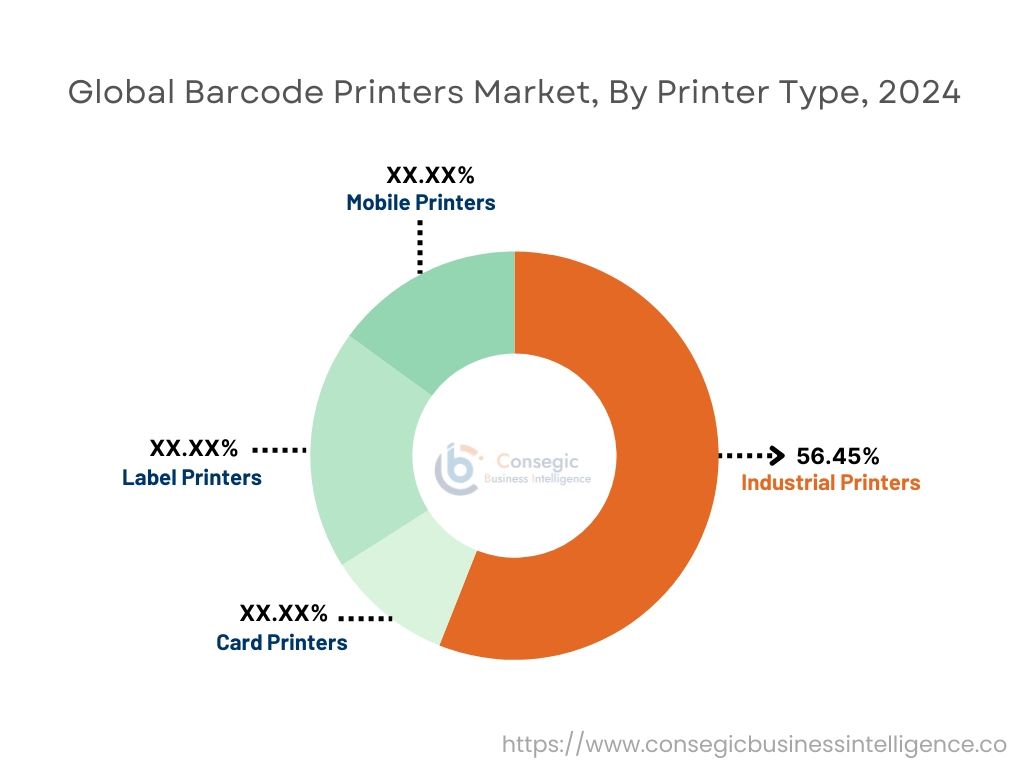
By Technology:
Based on technology, the market is segmented into thermal transfer, direct transfer, laser, impact, and inkjet.
Trends in Technology:
- The continual progress in printhead technology and media is resulting in higher resolution and sharper barcodes, enhancing scannability and minimizing errors.
- Printers are now quicker, featuring higher print speeds and enhanced processing capabilities, which increases productivity.
- Furthermore, printers are increasingly connected to the cloud, enabling remote management, print job queuing, and integration with cloud-based applications.
- Thus, based on the above factors and analysis, the growing demand of smart printing and enhanced printing quality would further drive the market trends during the forecast period.
The thermal transfer segment accounted for the largest revenue in the year 2024 and is expected to register the highest CAGR during the forecast period.
- Thermal transfer is widely utilized in barcode label printers to generate barcodes efficiently and cost-effectively on labels, tags, tickets, and other products while requiring minimal maintenance. This fast process produces clear, high-quality barcodes that are resistant to abrasion, chemicals, water, and fading.
- In healthcare, one of the main applications of thermal printers is printing patient identification wristbands. These wristbands need to be clear, durable, and resistant to water, heat, and chemicals to ensure patient safety and accurate identification during their time in medical facilities. Thermal printers deliver these essential qualities, making them vital for hospitals and clinics.
- The recent advancements in thermal printing, manufacturers can now incorporate advanced security features into their products, providing solutions that are challenging to replicate and highly dependable. Such features include UV printing, micro text, holographic elements, and tamper-evident seals, adding multiple layers of protection to printed materials.
- For instance, in February 2021, TSC Printronix Auto ID announced largest product update in industrial printer and print engines. The updates include enterprise mobility management capabilities, wireless connectivity options, and better printhead management. In the product update, TSC introduced two new industrial printers in the MH261 Series: the MH261T and MH361T, both 6-inch industrial thermal transfer printers. These performance models are well-suited for printing applications in logistics, manufacturing, retail, distribution, and healthcare.
- Thus, based on the above trends and factors, such as technological advancements in healthcare sector and increasing e-commerce demand would further supplement the global market during the forecast period.
By Print Width:
Based on the print width, the barcode printers market is segmented into 2 inches, 3 inches, 4 inches, and 6 inches or above.
Trends in the print width:
- There is an increasing demand for wider print widths to support larger labels and more intricate barcode designs.
- Advanced label design software enables users to effortlessly create labels in varied sizes and barcode formats, which can then be printed on printers with varying print widths.
- Thus, growing demand for wider print width and seamless integration with label design software would further supplement the barcode printers market trends during the forecast period.
The 4 inches segment accounted for the largest revenue share in the year 2024 and is expected to register the highest CAGR during the forecast period.
- Portable 4-inch printers are becoming more popular for on-the-go labelling in warehouses, retail settings, and field service applications.
- Manufacturers are prioritizing user-friendly designs with intuitive interfaces and straightforward setup procedures.
- As businesses increasingly automate their operations, the need for reliable and high-performance printing solutions grows.
- For instance, Zebra’s ZQ521 4-inch mobile printer is used to print receipts, labels, and linerless media. These printers are ideal for applications including packing, warehouse management, and cross-docking. Further, they also offer added strength and capabilities, such as better connectivity options, high-capacity battery, and USB on the go for better printer maintenance in the field.
- These advancements in the printers would further drive the barcode printers market share during the forecast period.
By Connectivity:
Based on the connectivity, the market is segmented into wired, wireless, and ethernet.
Trends in the connectivity:
- Barcode printers are now being integrated with various systems to automate tasks like inventory management and labelling.
- Mobile printing is gaining popularity as numerous businesses utilize mobile devices for their operations. Wireless printers enable convenient label and receipt printing from mobile devices, saving both time and money.
- Thus, growing need for mobile printing and increase automation would further supplement the barcode printers market trends during the forecast period.
The wireless segment accounted for the largest revenue share in the year 2024 and is expected to register the highest CAGR during the forecast period.
- Cloud connectivity is a growing trend in the barcode printer market. Cloud-connected printers allow for remote management, benefiting businesses with multiple locations. This connectivity also facilitates easier integration with other business systems.
- Modern wired printers feature user-friendly interfaces that enhance ease of use. This is crucial for minimizing training time and boosting productivity. Many printers now include touchscreens and intuitive software, simplifying the configuration of printer settings and label printing.
- For instance, Zebra’s ZQ600 Plus Series mobile printers is a first Wi-Fi barcode printer, which provide dependable and wireless connections for employees. The patented Power Smart Print technology delivers the precise amount of power needed for optimal printing quality, while PowerPrecision+ technology allows for easy identification of aging batteries before they affect productivity.
- Thus, based on analysis, these factors would further drive the market during the forecast period.
By Application:
Based on application, the barcode printers market is segmented into asset management, inventory management, package labeling, patient identification, product identification, shipping labels, wristband printing, ticketing, merchandising, pallet labels, compliance labelling, and others.
Trends in the application:
- The use of RFID-enabled printers is increasing as companies aim to improve their inventory management systems. RFID (Radio Frequency Identification) technology enhances conventional barcode printing by incorporating an additional layer of data capture and tracking. RFID-enabled printers can produce RFID tags alongside standard barcodes, offering enhanced inventory tracking features.
- Barcodes facilitate the tracking of raw materials, work-in-progress, and finished products, optimizing production processes and supply chain management.
- These factors, analysis, and advancements would further drive the market trends during the forecast period.
The package labeling segment accounted for the largest revenue share in the year 2024.
- There is an increasing focus on sustainable packaging and labeling practices, featuring eco-friendly materials, and minimized waste.
- The improvements in printing technologies, including RFID integration and digital printing, are facilitating more advanced and efficient labeling solutions.
- Brands are progressively adopting personalized and customized labels to boost customer engagement and brand loyalty.
- These factors, such as personalization and customization and technological advancements in package labeling segment would further drive market during the forecast period.
The wristband printing segment is anticipated to register the fastest CAGR during the forecast period.
- Innovations such as RFID-enabled wristbands and mobile printing solutions are enhancing the capabilities and applications of this technology.
- They are resistant to hand sanitizers and come in diverse sizes, softness levels, and colors.
- For instance, Delfi Technologies provides a range of wristbands for various applications, such as patient identification in healthcare and access control at events. They also offer printers that ensure efficient and reliable wristband printing.
- These factors would further drive the segment during the forecast period.
By End Use:
Based on end use, the market is segmented into retail, BFSI, food and beverages, manufacturing, transportation and logistics, travel & leisure, automotive, government, education, and others.
Trends in the end-use:
- As businesses work to enhance their operations and boost supply chain visibility, the need for printing solutions is on the rise.
- Innovations like mobile barcode label printers, wireless connectivity, and RFID integration are broadening the functionalities and uses of industrial printers.
- These factors, analysis, and advancements would further create the market trends during the forecast period.
The manufacturing segment accounted for the largest revenue share in the year 2024.
- The growing focus on industrial automation by manufacturers worldwide aims to streamline operations and enhance efficiency to boost output and minimize waste, thereby driving the adoption of printing solutions in the manufacturing process.
- Manufacturers are turning to automation technologies to improve efficiency, lower costs, and increase productivity. Barcode printers are essential in these efforts as they facilitate seamless data capture and integration across systems like Enterprise Resource Planning (ERP), Manufacturing Execution Systems (MES), and Warehouse Management Systems (WMS).
- To further enhance flexibility and efficiency, manufacturers are increasingly utilizing mobile and portable printing solutions. These devices enable workers to print labels on-demand at various locations within the facility, removing the need to transport goods to a central printing station.
- These factors and developments would further drive the segment during the forecast period.
The retail segment is anticipated to register the fastest CAGR during the forecast period.
- Retailers are increasingly using barcode label printers to improve the customer experience. This includes using barcodes for faster checkout, accurate pricing, and personalized promotions.
- Barcode printers are essential for inventory management, allowing retailers to monitor products throughout the supply chain, from receiving to point-of-sale. This capability aids in optimizing stock levels, minimizing waste, and avoiding stockouts.
- Retailers are increasingly utilizing mobile and portable barcode label printers to enhance efficiency and flexibility. These devices enable employees to print labels and receipts while on the move, removing the need to transport items to a central printing location.
- Barcode printers are commonly integrated with point-of-sale (POS) systems, automating transactions and capturing sales data. This integration simplifies checkout processes and offers valuable insights into sales and customer behaviour.
- These factors would further drive the segment during the forecast period.
Regional Analysis:
The global market has been classified by region into North America, Europe, Asia-Pacific, MEA, and Latin America.
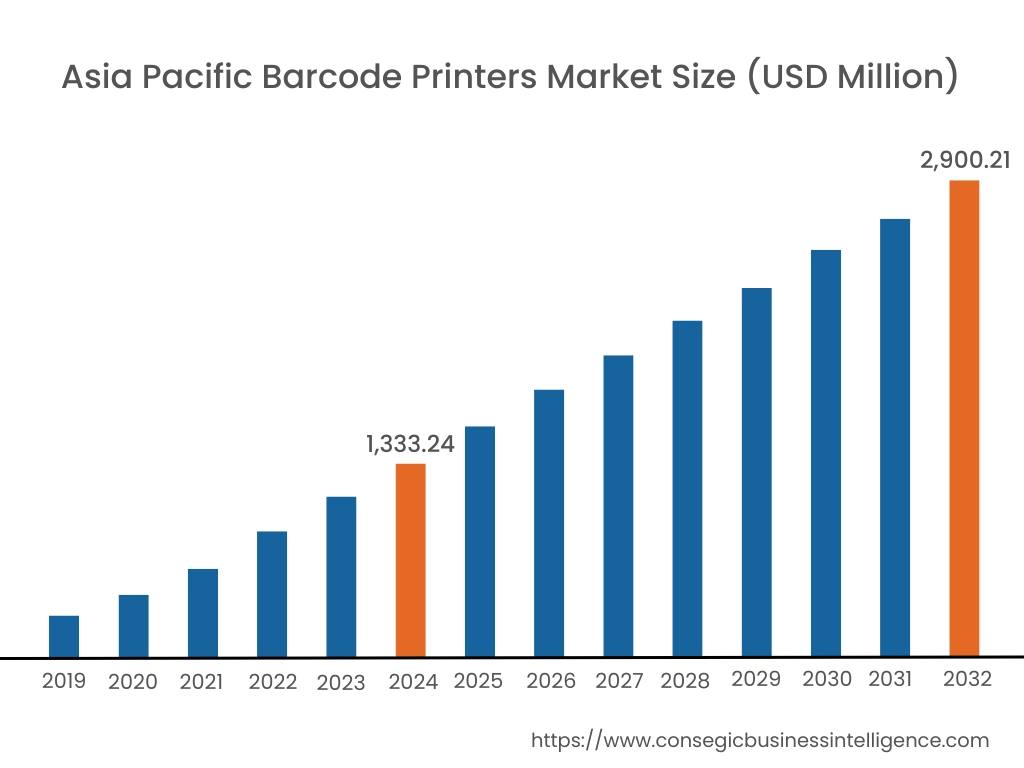
Asia Pacific barcode printers market expansion is estimated to reach over USD 2,900.21 million by 2032 from a value of USD 1,333.24 million in 2024 and is projected to grow by USD 1,456.50 million in 2025. Out of this, the China market accounted for the maximum revenue split of 24.56%. The regional market is set for rapid growth as several manufacturing companies in the region are adopting advanced printing technologies to benefit from streamlined workflows, lower costs, and improved quality assurance, driving the uptake of printers throughout the region. Further, the regional market participants are responding by launching innovative solutions that meet the changing needs of various end-use industries and sectors. Additionally, the rising need for packaged food in countries like China and India is expected to significantly boost the need for printing solutions during the forecast period. For example, the packaged food sector in India is anticipated to surpass approximately USD 70 million in the next 5-10 years, according to statistics from the India Brand Equity Foundation, positioning it among the world's leading processed food markets and creating further opportunities for printing solutions in developing economies like India. These factors and analysis would further drive the regional barcode printers market growth during the forecast period.
- For instance, in September 2023, HPRT, recognized for its cutting-edge printing solutions, presented its latest innovations in China's printing sector, revealing new development for the domestic market. Featuring a durable all-metal design, the iK4 displayed its capability to print labels as small as 3mm in height. By utilizing barcode technology, it enabled real-time tracking of parts and product information.
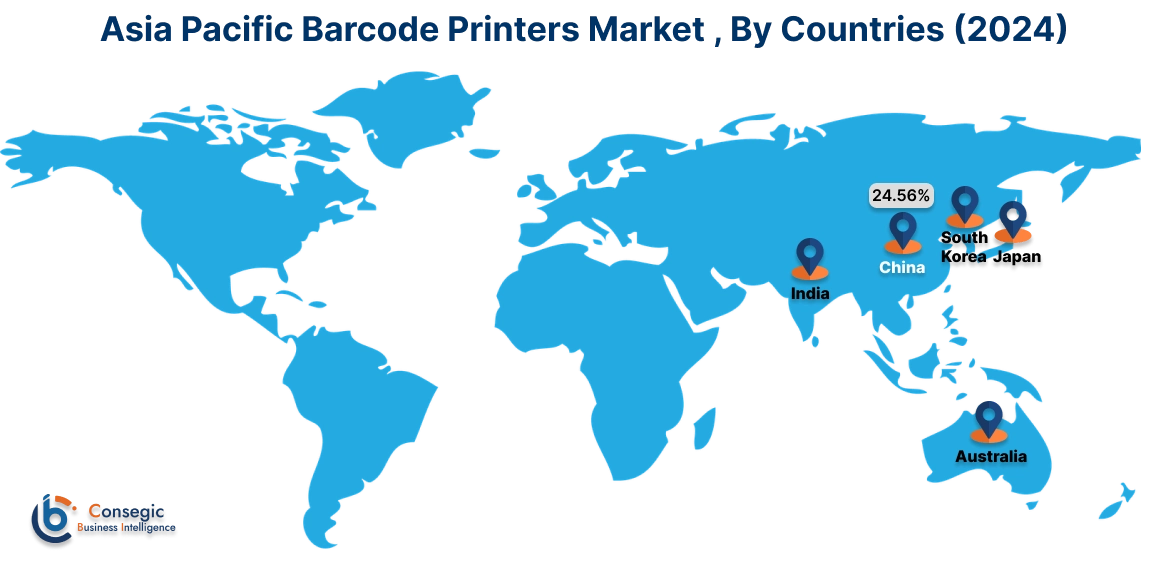
North America market is estimated to reach over USD 2,941.13 million by 2032 from a value of USD 1,437.72 million in 2024 and is projected to grow by USD 1,562.44 million in 2025. The North America region boasts a well-established infrastructure and invests heavily in research and development, making it the leading revenue contributor in the barcode printers market during the forecast period. The continuous growth of the e-commerce and retail sectors, coupled with the increasing preference for online shopping in the U. S. and Canada, is anticipated to boost the need for printing solutions. Industry players are focusing on automating various functions to improve operational efficiency.
- For instance, in April 2023, Barcodes, Inc. announced the partnership with SVT Robotics, to accelerate the rollout of its new AMR portfolio in manufacturing and warehouses settings. This collaboration seeks to streamline and hasten the integration of automation and robotics solutions, delivering quicker ROI and alleviating labor pressure. SVT’s low-code platform facilitates the quick integration of multiple robots and automation devices.
According to the barcode printers industry analysis, the European market has seen robust progression in the coming years. Europe's emphasis on sustainability is driving the advancement of eco-friendly printing technologies, such as recyclable label materials and energy-efficient devices. Countries like Germany, France, and Italy are experiencing substantial adoption of barcode systems in manufacturing and logistics. Furthermore, the transition towards automation and smart warehouses is boosting the need for portable and high-performance printers, establishing Europe as a crucial market for innovation. Additionally, in the increasing need for precise labeling and tracking systems in supply chains is a key factor driving the Latin American market. Regulatory requirements in industries such as food & beverage and healthcare are prompting businesses to invest in advanced barcode printing solutions. The region's emphasis on automation and sustainability is promoting the use of innovative, energy-efficient, and eco-friendly printing solutions. Furthermore, MEA market development is fueled by the retail and healthcare sectors, along with a heightened focus on enhancing operational efficiency. The growing adoption of technology and the emergence of small and medium enterprises (SMEs) are also significantly boosting the need for printing solutions in this region. Thus, based on barcode printers market analysis, these factors would further drive the regional market during the forecast period.
Top Key Players and Market Share Insights:
The global barcode printers market is highly competitive with major players providing printing solutions to the national and international markets. Key players are adopting several strategies in research and development (R&D), product innovation, and end-user launches to hold a strong position in the market. Key players in the barcode printers industry include-
- AVERY DENNISON CORPORATION (U.S.)
- Canon Inc. (Japan)
- SATO Holdings Corporation (Japan)
- Toshiba Tec Corporation (Japan)
- NEC Corporation Ltd. (Japan)
- Ricoh (Japan)
- Xerox Corporation (U.S.)
- Dascom (Hong Kong)
- Honeywell International, Inc. (U.S.)
- HP Development Company, L.P. (U.S.)
- Zebra Technologies (U.S.)
- BROTHER INTERNATIONAL (India) PRIVATE LTD. (India)
- Printronix (U.S.)
- Seiko Epson Corporation (Japan)
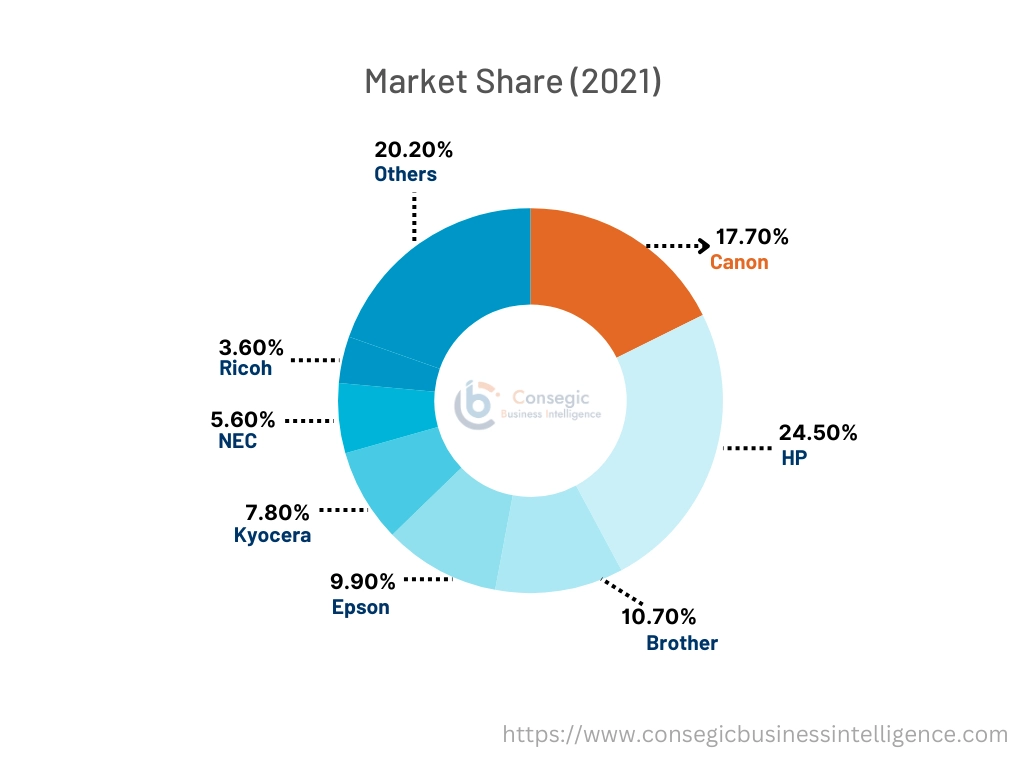
Recent Industry Developments :
Product Launch:
- In September 2024, Dai Nippon Printing Co., Ltd. launched two new transfer ink globally. The R380 provides enhanced alcohol resistance for printing barcodes and 2D codes on labels and tags. The V670 is excellent for printing on both paper food packaging and plastic, making it perfect for date and production number printing.
Barcode Printers Market Report Insights :
| Report Attributes | Report Details |
| Study Timeline | 2019-2032 |
| Market Size in 2032 | USD 9,742.07 Million |
| CAGR (2025-2032) | 8.3% |
| By Printer Type |
|
| By Technology |
|
| By Print Width |
|
| By Connectivity |
|
| By Application |
|
| By End-Use |
|
| By Region |
|
| Key Players |
|
| North America | U.S. Canada Mexico |
| Europe | U.K. Germany France Spain Italy Russia Benelux Rest of Europe |
| APAC | China South Korea Japan India Australia ASEAN Rest of Asia-Pacific |
| Middle East and Africa | GCC Turkey South Africa Rest of MEA |
| LATAM | Brazil Argentina Chile Rest of LATAM |
| Report Coverage |
|
Key Questions Answered in the Report
How big is the Barcode Printers market? +
Barcode Printers Market Size is estimated to reach over USD 9,742.07 Million by 2032 from a value of USD 4,728.02 Million in 2024 and is projected to grow by USD 5,141.25 Million in 2025, growing at a CAGR of 8.3% from 2025 to 2032.
Which is the fastest-growing region in the Barcode Printers market? +
Asia-Pacific is the region experiencing the most rapid growth in the market. The Indian government's emphasis on enhancing manufacturing through initiatives such as Make in India and Digital India is driving the need for effective inventory and supply chain management tools. Additionally, Japan’s automotive and electronics sectors are prominent users of barcode printing technologies, which play a crucial role in optimizing production and supply chain operations. The combination of barcode systems with robotics, IoT, and AI-driven platforms is also increasing demand.
What specific segmentation details are covered in the Barcode Printers report? +
The Barcode Printers report includes specific segmentation details for printer type, technology, print width, connectivity, application, end use, and region.
Who are the major players in the Barcode Printers market? +
The key participants in the market are AVERY DENNISON CORPORATION (U.S.), Canon Inc. (Japan), Dascom (Hong Kong), Honeywell International, Inc. (U.S.), HP Development Company, L.P. (U.S.), Zebra Technologies (U.S.), BROTHER INTERNATIONAL (India) PRIVATE LTD. (India), Printronix (U.S.), Seiko Epson Corporation (Japan), SATO Holdings Corporation (Japan), Toshiba Tec Corporation (Japan), NEC Corporation Ltd. (Japan), Ricoh (Japan), Xerox Corporation (U.S.) and others.
